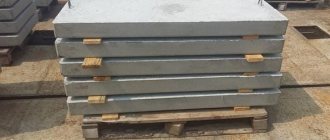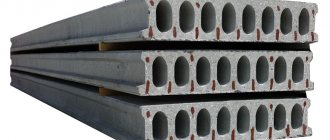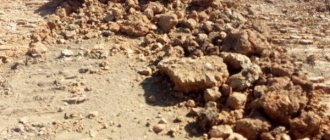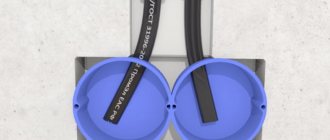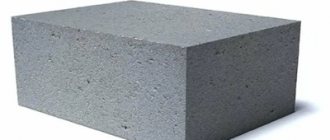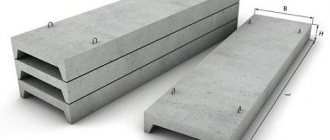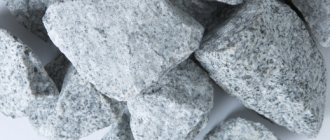The arrangement of sidewalks and local areas requires the use of high-quality materials. When laying paths, concrete paving slabs are used, which are durable and have a long service life. Products are manufactured in compliance with technology, meet established standards, and are labeled.
Advantages and disadvantages of application
The main advantages of road slabs include:
- simple installation technology, which increases installation speed and simplifies construction work while maintaining high quality coating;
- relatively low cost of materials used;
- reduction of costs for soil development and related work;
- high reliability, strength and frost resistance of the coating;
- possibility of recycling the material after dismantling.
The main disadvantage is the presence of seams, which do not allow obtaining a perfectly flat surface. However, using asphalt as a topcoat or sealing joints with mortars helps eliminate this disadvantage and improve the quality of the surface.
Airfield plate PAG.
About the pros and cons of technology
The use of reinforced concrete products in road construction is beneficial for the following reasons:
- Relatively small budget required for laying road slabs; nice price/quality ratio.
- Quality. The slab material is manufactured in a factory and has strictly regulated performance characteristics.
- Long lasting results. A road or platform made of road slabs, built in accordance with the technology, will last 30-40 years.
- Simple technology with high performance. Ready-made concrete products are stacked using a truck crane or other crane equipment. The speed of installation does not affect the quality of the coating.
- High performance characteristics. The road surface is durable, wear-resistant, resistant to dynamic loads and weather factors. In Russian conditions, the resistance of the road surface to a wide temperature range (from -50 to +55°C) is especially important.
- Reuse. The temporary road surface can be dismantled and reused (if the reinforced concrete products have not reached the end of their strength life).
Laying a slab in a roadbed Source sevparitet.ru
The connecting seams between the slabs are considered a significant drawback. If it is necessary for the surface to be perfectly flat, a layer of asphalt is placed on top, but this makes the project more expensive. On short roads, the seams are sealed with mortar.
Classification
Road slabs are classified according to their purpose, geometric shape and dimensions in accordance with GOST 21924.0-84. According to their intended purpose, they are manufactured for permanent and temporary road surfaces. PAG airfield slabs, which have increased strength, are considered as a separate type of product. The type of products is determined by the marking. If “1” is used as the first digit, then this indicates the use of the material as a permanent coating, and the number 2 means temporary.
According to their geometric shape, reinforced concrete road slabs are divided into:
- rectangular grades P;
- with one or two combined sides - PB, PBB;
- PT – with a flat trapezoidal surface;
- PSh, PShD, PShP, DPSh, PPSh – hexagonal structures and their additional elements.
The most common products are rectangular in shape, as they are the easiest to manufacture, install and are in the best demand. Their length can range from 1.75 to 6.00 meters, and their width can range from 1.00 to 3.75 meters. More detailed data is provided in the tables.
Marking examples:
- HDPE 6×2 – with prestressed reinforcement, length 6.0 m and width 2.0 meters;
- HDPE 3×1.5 – with prestressed reinforcement, 3.0×1.5 meters;
- road slab 2P 30 18 30 – for temporary roads, 3.0×1.8 m, designed for a permissible weight load of up to 30 tons;
- 2P30.18-10 – for temporary roads, 3.0×1.8 m, designed for a permissible weight load of up to 10 tons.
Other types are marked in a similar way, including information about their purpose, geometric shape and size.
The use of materials for airfield decking in road construction allows us to obtain a particularly strong and durable coating with a soft corrugated surface, which will ensure better vehicle stability on the road. Reinforced reinforcement grades and the highest quality concrete are used for production.
Features and Specifications
Reinforced concrete slabs are a popular material in the building structures market. Thanks to its universal configuration and optimal dimensions, concrete paving slabs can be used for:
- territories of any type;
- public transport stops;
- urban highways;
- areas;
- park paths;
- playgrounds;
- flower beds;
- sidewalks;
- areas.
The products are designed for high weight loads and are resistant to deformation. The canvas made of slabs remains clean during the rainy season, and in the cold season it is safe for pedestrians, thanks to the rough surface.
The advantages of the material are as follows:
- the possibility of arranging entrance groups, recreation areas, courtyards;
- long service life;
- resistance to loads;
- external parameters;
- possibility of laying patterns, drawings;
- strength;
- ease of installation and care;
- convenience during dismantling associated with re-laying communications;
- the ability to imitate granite, marble and other natural materials.
Unlike facing material, paving slabs are made in the shape of a rectangle or square.
Products are not reinforced if their structural thickness allows. When the thickness exceeds 75 mm, structural reinforcement with wire is used. To lift and move structures, mounting loops with a diameter of 6 mm are introduced.
The slabs are made from a special concrete mixture in 1 or 2 layers. Products comply with specified production standards and meet GOST requirements. The water absorption rate of the products does not exceed 6%, strength - 3 MPa, wear resistance - 0.7 g/cm2.
Construction of reinforced concrete slabs
Reinforcement base of slabs.
Structurally, the slabs are flat reinforced concrete products 140-240 mm thick with prestressed or unstressed reinforcement. For convenient installation, they can have metal loop grips that are hidden in the body of the monolithic structure and do not protrude onto the surface of the road surface.
The main building material for production is concrete, which protects the reinforcing reinforcement structure from adverse atmospheric and mechanical influences. For the manufacture of road slabs, concrete with frost resistance of at least 150 cycles and a density of 2.2-2.5 tons/m3 is used.
In the manufacture of prestressed reinforcement cages, steel reinforcement grades A-5, AT-5 and AT-4 are used. In the case of non-stressed structures, reinforcement grades A-1, A-3 and A-3C are used, as well as BP-1 wire with a diameter of 6-8 mm.
When storing, finished products are placed on a flat, solid base using transverse wooden supports. Further laying of road slabs in the warehouse occurs using wooden spacers between all rows.
Slab shapes.
Factory manufacturing technology
The technology for forming a reinforced concrete road slab begins with preparing the mold. At this stage, all walls of the mold are lubricated with a special lubricant to facilitate the process of future formwork. After that:
- two reinforcing meshes are installed, for the correct spatial position of which plastic stops of the “circle” or “star” type are installed on the reinforcing bars;
- The concrete mixture is placed inside the mold and compacted using vibration;
- The concrete is heat treated with hot steam in a heating chamber for 8-12 hours;
- The finished product is demolished, the quality of workmanship is checked and it is marked in accordance with the type of slab.
Next, the products are sent to the warehouse, where they are stored until shipment to the buyer for at least 92 hours (4 days).
How to do it manually?
If you decide to make the tiles yourself, you should first prepare a regular concrete mixture at the rate of sand, cement and crushed stone - 1:1:2. It is possible to add plasticizers (about 5% by weight of cement). Along with the additives, the desired coloring pigment is also introduced. Water is introduced in quantity so that the solution comes out with a medium consistency.
It is recommended to mix the ingredients in a concrete mixer. The entire prepared concrete solution should be used at one time. At home, of course, there is often no vibration table. Therefore, it is recommended to use reinforcing mesh for strengthening. First, pour out half of the solution, level the surface with a trowel, then put in a reinforcing mesh and add the rest of the mixture. After which it is compacted again with a trowel.
To simplify the task, they often use ready-made rubber molds for pouring. But in the absence of such, they are made independently from a wooden panel, upholstered in iron, with removable formwork (sides) and impregnated with hot drying oil. Afterwards, using a building level, check the evenness of the poured tiles. This is important for obtaining slabs of the same height. The process itself is similar to that described above, the conditions are the same. Thus, you can significantly save money and make tiles of different shapes and colors to suit your taste by adding the coloring pigment you like. The process is relatively long and labor-intensive, but the result will exceed all expectations.
Return to contents
Laying technology on public roads
Due to their versatility, reinforced concrete road slabs are used not only in large-scale road construction, but also for paving paths and driveways for vehicles on private plots of private buildings.
When paving roads and passages of public importance, preparation of the base depends on the purpose of the road in terms of the expected duration of use. It is considered sufficient to prepare a compacted sand bed for temporary roads, driveways and platforms, and lay the road slabs themselves without installing curb stones.
Permanent concrete roads must be laid on a multi-layer base consisting of:
- drainage crushed stone layer;
- non-woven geotextile flooring;
- dense sand cushion.
The importance of using a sand bed.
In this case, the installation of curbstones along the edges of the road is mandatory. Every 10 meters between the stones it is necessary to leave gaps of 5-7 cm for normal drainage of rainwater from the road surface.
The drainage layer is poured into a “trough”, which is obtained by removing the top layer of soil along the entire width of the future road to a depth of 25-30 cm.
After this, the crushed stone is well compacted and covered with a layer of geotextile, on which a sand cushion 10-15 cm thick is poured. The road slab is laid on compacted sand, followed by sealing the mounting grooves with loops with cement mortar or fine-grained concrete. As the outermost elements of the roadway, it is recommended to lay PB or PBB with combined side projections adjacent to the curb stone.
To improve the quality of the road surface, the surface can be rolled with asphalt or filled with a continuous layer of concrete screed.
Main types and technologies for the production of paving slabs
Today, the two main types of concrete paving slabs are most in demand – vibro-cast and vibro-pressed. Typically, the first is used mainly in the private sphere, the second is actively used on an industrial scale, along with granite paving stones. Product characteristics directly depend on the raw material base and production technology.
Vibration casting technology is the prerogative of small private enterprises, as it involves manual labor with minimal involvement of equipment. The mortar for making tiles is a mixture of cement, sand and water, with a fairly liquid consistency. Also, the solution may contain plasticizing additives and pigment, mainly of organic origin, since it is cheaper and gives a brighter shade. The solution is poured into molds installed on a vibrating table, where the concrete is compacted under the influence of vibration for a certain time. After two days, the tiles are removed from the molds and sent to the racks for natural maturation and strength gain.
Vibrocompression is a technology for large factories, as it requires a complex, expensive, automatic production line. The raw material mixture includes not only cement and sand, but also crushed stone, which is due to the direct relationship between the strength of concrete and the strength of its largest filler. As with vibration casting, during vibrocompression, modifying additives are introduced into the solution, but minimal water is added, just enough for hydration. The mixture is not poured into molds, but filled in, as it is a homogeneous semi-dry mass. The molds (matrices) enter the press, where the concrete is compacted under double influence: vibration and high pressure. This is followed by stripping, and the pallets with tiles are sent to the holding chamber, where high temperature and humidity are maintained. This stage allows the concrete to quickly gain grade strength under optimal conditions. The bulk of collections of vibropressed tiles today are produced using double pressing technology - the main layer is a mixture of cement, sand and crushed stone; facial – cement, sand and pigment (inorganic).
Roman ChizhovChief technologist
Concrete components: cement, sand, crushed stone, water. According to the current GOST 17608-2017, crushed stone must be used in everyday life. Special additives have a much smaller effect on strength and durability than high-quality raw materials and strict adherence to production technology.
Two types of pigments are used for concrete:
- organic (acid-based) - cheap and bright, but fade quickly.
- inorganic (based on oxides of iron, titanium, cobalt and chromium) - more expensive, but durable and not affected by organic solvents.
The use of reinforced concrete slabs in private construction
The use of road slabs when arranging a personal territory allows you to quickly and inexpensively make entrances to a building, garden paths or sidewalks. At the same time, for access roads and vehicle passages, large slabs 3-6 meters long with a permissible load of up to 10 tons are usually used. For example, 2P30.18-10, 2P60.1,8-10 or HDPE road slab 6000x2000x140. It is not advisable to use more powerful products in private construction.
Preparing the base.
To ensure the durability of the road, heavy road slabs should be laid on a prepared base with a drainage crushed stone layer and an intermediate geotectile coating, which will prevent the germination of weeds in the joints between the tiles.
For pedestrian paths, it is convenient and profitable to use hexagonal, trapezoidal or small rectangular products of relatively low strength, since the load on such coatings will be small.
As a base, a compacted sand cushion, under which a layer of geotextile is spread, is sufficient. This material will prevent possible germination of weeds and, at the same time, allow rainwater to flow freely into the ground. To guarantee the preservation of the geometric dimensions of the path, it is desirable to have a concrete curb.
It is necessary to cut or chop reinforced concrete slabs to the required size along the existing reinforcement or across it, at a distance of at least 250 mm from the edge. All hinge grooves must be filled with fine-grained concrete, and the seams must be sealed with liquid cement mortar.
Advantages of paving slabs
Paving slabs, widely used for paving both in cities and in the private sector, are attractive for many characteristics. But just as a person is “met by his clothes,” the path, first of all, attracts attention with its appearance, and paving slabs provide it with this attractiveness.
1. Highly decorative
Manufacturers offer a huge selection of formats and several texture options, coupled with a wide range of colors and ColorMix technology for mixing shades. This variety allows you to implement any design ideas without restrictions, harmoniously combining paving with the surrounding architecture and landscape style. If you want to imitate ancient pavements, you can use the corresponding collections for paving.
Roman ChizhovChief technologist of the Steingot plant
Classic and small square shapes really resemble stone paving stones. But in recent years, comfort and safety have been in trend, so preference is often given to medium format tiles with minimal bevels or no bevels at all.
The original shade of paving slabs practically does not change over time (for high-quality materials), thanks to which paths remain one of the basic elements of landscape design for a long time.
2. Ease of installation and maintainability
Laying paving slabs, even large format ones, does not require complex preparation of the base using heavy construction equipment. If necessary, you can easily replace one or more cracked elements without completely dismantling the coating. It happens that under an already laid path it is necessary to install or repair communications; to do this, it is also enough to disassemble the tiles and put them back when the work is completed.
3. Operational safety
If paving technology is followed, puddles do not form on the surface of the path, and the tile itself does not slip even when wet and remains comfortable and safe when moving.
Roman ChizhovChief technologist
Sprinkling the seams and then thoroughly compacting the sand in the seams with a vibrating plate is primarily necessary to ensure that the bulk of the water is drained along the surface of the tile into the drainage system. Therefore, the slope of the paving surface is also required. It is understood that very little water should get through the seams under the surface of the tile - a small amount will have time to escape through the tightly compacted layers of the base.
4. Comfort
Paths are a functional and decorative element of landscaping and should not only decorate the area, but also be as comfortable as possible for its inhabitants. It is quite possible to achieve this effect if you use modern collections of paving slabs.
Roman ChizhovChief technologist
Today, comfort in conjunction with paving slabs is understood to mean a flat surface with minimal seams and chamfers. The trend was set several years ago by city architects and now we all know the “Comfortable Environment” program.
5. Eco-friendliness
The climate is changing and hot summers are no longer uncommon even in the central regions and to the north, not to mention areas where above 30˚C has long been considered “cool”. And some coatings, for example, asphalt, begin to release harmful chemicals into the atmosphere already at 25 ˚C. Whereas concrete, even with strong heating, does not change from one state of aggregation to another and does not release anything into the air. And the composition of concrete paving slabs, in principle, does not imply the presence of any potentially harmful additives.
6. Durability
Properly laid tiles, coupled with proper preparation of the base, will provide decades of service without the need for repairs. High-quality paving slabs do not fade, do not wear out and do not require complex care or periodic renewal. The service life of concrete paving stones is from 15 years, which is due to high frost resistance (F100-200 cycles). Even taking into account the initial investment, in the long run it is much more profitable to spend money on paving with good concrete paving stones once and for many years, rather than redoing the paths every few years.
7. Practicality
Concrete paving slabs are characterized by minimal permeability - they practically do not absorb moisture, and therefore do not absorb dirt either. If necessary, it is enough to periodically wash off the surface of the paths with water from a garden hose with a spray nozzle. In extreme cases, cleaning with a pressure washer may be necessary, but this is rare under normal operating conditions.
New types of reinforced concrete slabs for paving
Today, manufacturers offer private developers piece reinforced concrete products for paving paths of square, rectangular, triangular, rhombic, polygonal and other shapes. In this case, the surface of road slabs can be either colored or ordinary gray. The concrete surface is made smooth or embossed to reduce the likelihood of slipping on a wet surface.
Diagram of the laid slab.
Using them, you can create a very original design of the garden area around a residential building. It is allowed to use combinations of laying road slabs with colored gravel, paving stones, paving slabs and other materials. The basis for them should be a two-layer gravel-sand cushion.
Properties of different types of tiles
The choice of paving slabs should be approached comprehensively, taking into account the technical, operational, and aesthetic properties of the material, which is laid not for one year, but ideally for more than one five-year period.
Texture - vibro-cast tiles are smooth, on the one hand, they become less dirty, on the other hand, like granite, it is easier to slip on them after rain or in icy conditions. Vibration-pressed tiles with a rough surface win in this regard.
Aesthetics - initially vibropressed tiles were produced in the form of rectangular paving stones in a very limited range, including several shades of gray. Whereas the vibrocast one was replete with a large number of complex shapes and bright, saturated colors and attracted gloss. However, today manufacturers have not only expanded the palette many times and diversified the forms, but also learned to mix shades, obtaining different visual effects. A brick press can imitate different types of natural stone and clinker, and the collections are replete with pastel and bright colors. In addition, due to the durability of inorganic pigments and minimal abrasion, the original color of the tiles remains virtually unchanged over the years, and the paths do not lose their presentability.
Ease of use - both vibro-cast and vibro-pressed tiles are now laid primarily using a dry method without the use of mortar. But due to the ideal geometry, it is easier to work with vibropressed, an even plane and identical seams are obtained without additional effort.
Availability - at first glance, vibro-cast tiles are the leader in this parameter, since their price is much lower, which is most important for large paving areas. For comparison, the cost of a vibration-casting square starts from 350 rubles for a simple gray mold, and a vibration-pressed square starts from 800 rubles. If we look at exclusive collections of brick making machines, then the cost is already around one and a half to two thousand rubles. Vibrocasting, in principle, is not exclusive, but more complex forms in bright colors will cost about 600 rubles per square. However, not everything is so simple, given that the cost-effectiveness of paving needs to be considered in the long term, large initial investments will be “repaid” due to the increased strength and durability of vibro-pressed tiles.
Basic principles of proper path markings
Marking is the first stage of work on arranging paved surfaces of pedestrian paths. The appearance, durability and ease of use of the territory largely depend on its correct implementation.
The width of the path should be such that 2 people can easily separate on it when meeting, but not less than 0.8 meters.
The pedestrian path running along the passage for a car must ensure the safe movement of a person while the car is moving.
The installed hard covering must be laid at a distance of at least 1.5 meters from garden trees so that growing roots do not subsequently damage the base. It is necessary to provide for the presence of slopes on the surface of the path to drain rain and melt water. At the same time, it is important to exclude the possibility of their entry towards residential buildings and outbuildings.
